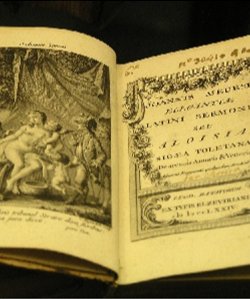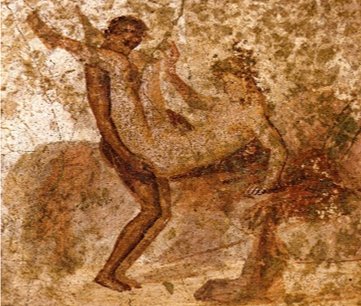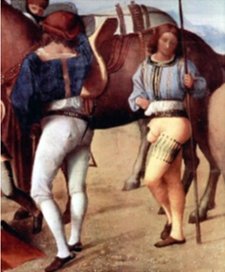"A dirty book is rarely dusty."
Ancient Times
Throughout time, we've found various ways in which to explore and exhibit our sexual sides. Primal man created cave paintings, and their erotic art can still be found throughout the world to this day. The Romans, millenia ago, created plays and sculptures. Verse, stories, and novels were added along with more modern paintings, as the centuries went on. In today's time, we've added magazines and movies depicting our erotic fantasies and enjoyments. All these advances in our erotic evolution have mirrored our evolution as a species.
Between 35,000 and 5,000 years ago, ancient man, throughout the world, would use red iron oxide and various berry pigments to decorate caves and the various structures they lived in. Many of the drawings they created showed scenes of their daily lives. There were paintings of hunts, animals, and battles. Along with these more mundane scenes, were more erotic and sexual depictions. In most of these paintings, women were shown with large breasts, curvy thighs, and rounded stomachs. The men were often shown with a highly enlarged phallus. The explicit enlargement of sexual organs on both sexes made it quiet clear that the images were created for erotic enjoyment.
Moving ahead in time to just 2,000 years ago, one finds the world full of sculptures and mosaics. Throughout the Roman Empire, India, and ancient Asian areas, erotic art can be commonly found. Artists wanting to explore their sexual natures created more realistic depictions. Men were shown in full nudity, their bodies rigid and well muscled. Women were shown with smaller stomachs and engaged in more blatant acts of sexual intercourse. The famous Kama Sutra was sketched into stone in fine detail, bodies intertwined intimately.
Along with these more intimate and realistic acts being shown, the sexual couplings had changed. Men were beginning to be shown in sexual congress with other men. Women were shown engaging in acts with both sexes. Orgies of various sexes and positions were depicted explicitly. It was perhaps the first time homo-eroticism had been shown so publicly or widely.
Between 35,000 and 5,000 years ago, ancient man, throughout the world, would use red iron oxide and various berry pigments to decorate caves and the various structures they lived in. Many of the drawings they created showed scenes of their daily lives. There were paintings of hunts, animals, and battles. Along with these more mundane scenes, were more erotic and sexual depictions. In most of these paintings, women were shown with large breasts, curvy thighs, and rounded stomachs. The men were often shown with a highly enlarged phallus. The explicit enlargement of sexual organs on both sexes made it quiet clear that the images were created for erotic enjoyment.
Moving ahead in time to just 2,000 years ago, one finds the world full of sculptures and mosaics. Throughout the Roman Empire, India, and ancient Asian areas, erotic art can be commonly found. Artists wanting to explore their sexual natures created more realistic depictions. Men were shown in full nudity, their bodies rigid and well muscled. Women were shown with smaller stomachs and engaged in more blatant acts of sexual intercourse. The famous Kama Sutra was sketched into stone in fine detail, bodies intertwined intimately.
Along with these more intimate and realistic acts being shown, the sexual couplings had changed. Men were beginning to be shown in sexual congress with other men. Women were shown engaging in acts with both sexes. Orgies of various sexes and positions were depicted explicitly. It was perhaps the first time homo-eroticism had been shown so publicly or widely.






Love this article!